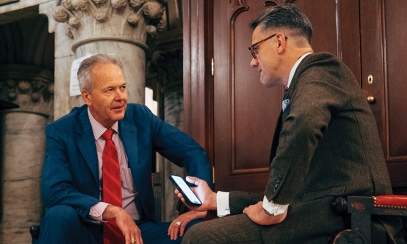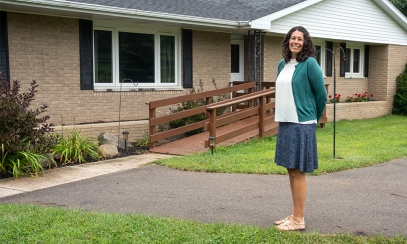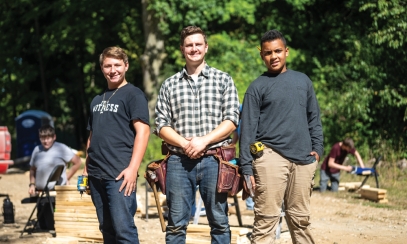
Gospel Writers Watch Over the Baptismal Font at St. Peters
The new icons that watch over the baptismal font at St. Peter parish have a long history. The images trace back to Ravenna, Italy. The painter, John Hofland, traces his journey with iconography back to Ukraine in 1995, during the period following Perestroika and the fall of the Soviet Union.
The Iconographer
At that time, Hofland had the opportunity to teach in Ukraine. Although he was then a protestant, he took the chance to visit the Cathedral of St. Sofia in Kyiv, which is no longer a functioning church, but a museum. “I walked in there and with all these icons painted up the sides all the way to the top, it blew me away, it was amazing. And so I began sneaking into churches while I was there to look at more icons,” Hofland said.
In Ukraine, Hofland found himself teaching courses at the university about American culture and the Bible as literature. His background, however, was in scenery painting for theater, which helped him appreciate the art he found in European churches, despite the fact that he was raised and worshiped in the Christian Reformed tradition.
Hofland’s experience in Ukraine was not only the start of his journey in appreciation of iconography, but also a curiosity about the Catholic faith. Speaking about his small church in Ukraine, Hofland said, “We went to this little evangelical church. It met in an old historical building. We went to this church all the time, but we noticed the minister there was a little standoffish.” Prior to Hofland’s visit to Ukraine, the same college Hofland was affiliated with had attempted to establish ties with the pastor to help build up their network of support in Ukraine. “When we were getting ready to leave, he invited us for ice cream,” Hofland explained, “which was a big thing at the time in Ukraine. He explained he didn’t want to get too close to us, because previous to us coming, people from our college had come to him to help build up a connection between Ukraine and the college. So they were looking for key people. They wanted to know if he was orthodox enough. Apparently it was very awkward for him.” This question of “orthodox enough,” and his own questions about which denomination to follow (which came from his own childhood experience in a household split between two denominations) had him looking for “the right church.”
“I was looking for a more liturgical faith,” Hofland said. So when he and his family settled in Spokane, they explored many of the local churches. They visited the Byzantine Catholic Parish in Spokane Valley, St. Augustine, and some protestant churches as well. They also visited St. Peter, and appreciated Father Mee’s preaching. As they were attending St. Peter, Hofland said he noticed that the parish’s altar area and statues looked very drab. He went to Father Mee one day, pointed out that the statues didn’t stand out, and offered to paint them. Father Mee was shocked by the idea, this conversation, along with input from other parishioners and priests, led to ideas about lighting and stenciling on the wall behind the altar to help the statuary and altar area stand out better. Hofland helped install the lighting.
This artistic venture with Father Mee prompted Hofland and his wife to settle into parish life, take Father Mee’s historical classes on topics like the Reformation, and eventually enter RCIA.
Journey to Iconography
“A few years ago, I noticed they were putting on these icon workshops at the retreat center and it kind of caught my eye. I always wondered how these were done, and every time I could, I would just kind of stare at them,” Hofland said. He debated attending the workshop each summer at Immaculate Heart Retreat Center, wondering if learning to paint iconography would be practical. Would he use the skills? At the workshop they were asked to paint half of a diptych of the annunciation, meaning they could paint either the angel Gabriel or the Virgin Mary.
Sister Mary Eucharista, who organizes programming at the retreat center, had seen Hofland’s icon of the Virgin and told Father Jeff Lewis about his work. Father Lewis asked Hofland if he could see it. After taking a look, Father Lewis broached the idea of painting the four Gospel writers in the parish. Hofland wasn’t ready to take on the task yet, and returned to the icon work-shop for another week of training and experience.
In the meantime, St. Peter was assigned a new pastor, Father Lucas Tomson. When Father Tomson met Hofland, he said “Oh, you’re the iconographer.” This conversation brought the idea of the icons of the Gospel writers back to life.
Hofland said painting the icons was beneficial spiritually. “Putting myself at the service of someone else’s work was good spiritually in a practice of humility,” he said. Icons tend not to be an author’s unique creation, but a variation on a theme running through similar icons. The painter keeps within the tradition of that school of iconography.
The Icons
Hofland began work on the icons during the fall of 2019 and was able to complete it during Lent of 2020.
As Father Lucas Tomson and John Hofland were planning the project, Hofland said he had Greek-style icons in mind. “I wanted to make sure that the iconography would match the style of the church,” said Father Tomson. “Our parish church was roughly modeled off of San Vitale in Ravenna. So we looked at the photos of the Gospel writers from Ravenna.”
The creation of each icon begins with a prayer written onto the canvas. “Appropriately, the prayer in Luke was for Father Lucas Tomson,” Hofland said. Others were for people close to the artist. Each day of work also began with an iconographer’s prayer, taken from the eastern Christian tradition.
“I had really nice pictures of the mosaics, so that became a good color model and so forth,” Hofland said. The icons were based on the mosaics from Ravenna, but were modified to fit the needs of the parish, like turning all the Gospel writers’ heads to face the altar, using a model of a lion from another icon, and other small changes. To transition the ancient look of the icons to the more contemporary design of the parish building, Hofland simplified the original ornamentation around the icons and modified the colors to match the colors of St. Peter parish.
“The whole process was a big learning process,” Hofland said. The painting was done on stretched canvases in egg tempura, meaning Hofland worked with pigments taken from the natural world, combined with an egg base to make the paint. This method of painting applies thin layers of color and requires endless patience to bring the vivid colors to life.
“I’ve come to love them as I walk into that space,” Father Tomson said, “and the people really seem to like them. People are moved by the Gospel figures, learning which symbol is associated with each writer.”
The Icons
ST. MATTHEW is signified by an angel who represents the genealogies that begin his Gospel. St. Matthew is seen writing his Gospel in Hebrew. Father Tomson and Hofland had the assistance of a Hebrew scholar to make sure the words were correct. The Hebrew text translates as, “The Gospel according to Matthew.”
ST. MARK is represented by the lion, as his Gospel narrative begins with the prophetic account of St. John crying out in the wilderness. His Gospel text is in Latin and reads “according to Mark.”
ST. LUKE is signified by an ox. His Gospel begins telling the accounts of both John the Baptist and Jesus’s birth, and in that way, is connected to priestly sacrifice. His Gospel text reads in Latin, “according to Luke.”
ST. JOHN is represented by an eagle, which flies heavenward toward the sublime reality of God. John’s Gospel begins with an account of the beginning of all things, and draws a connection between God’s reality and the incarnation. His Gospel text, also in Latin, reads, “according to John.”



